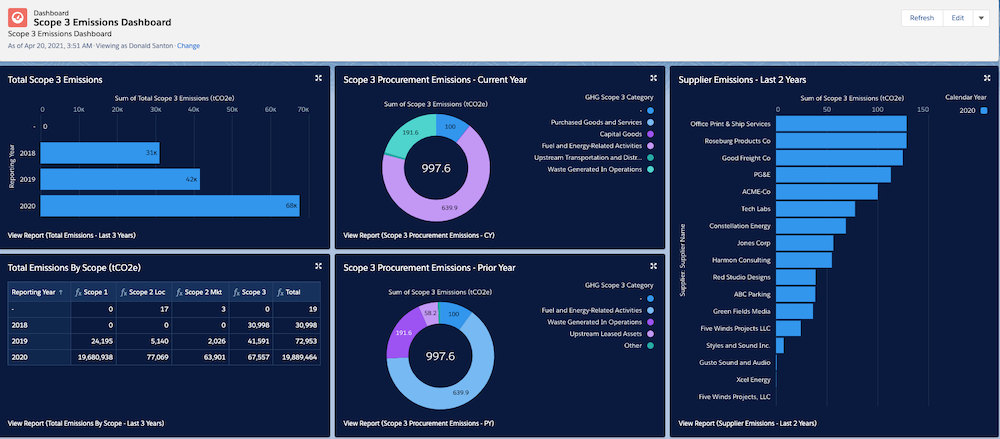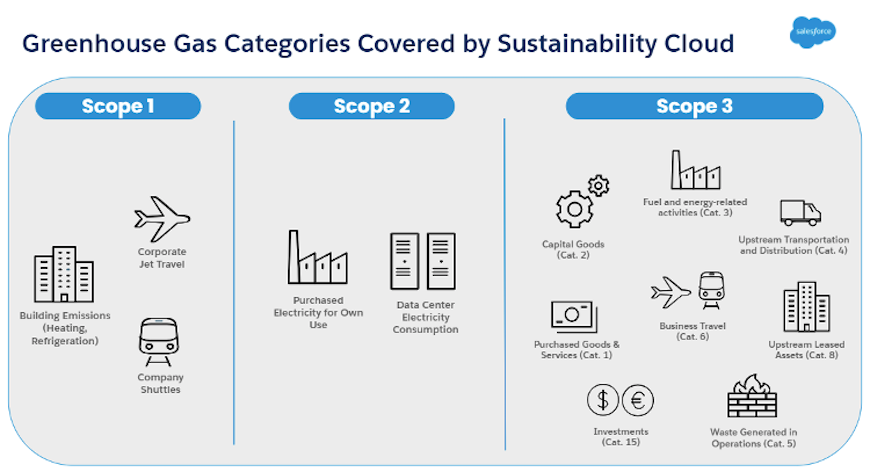Editor’s Note: This article references Salesforce Sustainability Cloud, which is now known as Net Zero Cloud. For the latest on Salesforce’s sustainability solutions, check out this product page. For the latest news on Salesforce’s sustainability efforts, check out this page.
- With Sustainability Cloud, customers can now track scope 3 emissions, or value chain emissions, such as from purchased goods and business travel, which typically account for the majority of a company’s carbon footprint.
- Salesforce’s 1.5 degree Science Based Target includes a commitment that 250 of its top suppliers, representing 60% of the company’s scope 3 emissions, will set Science Based Targets of their own by 2024. As of 2020, suppliers representing 28% of our emissions have set or committed to such goals.
- Salesforce commits to reducing business travel carbon emission intensity by 50% relative to pre-pandemic levels by reducing, decarbonizing and substituting. Since 2019, Salesforce has offset all business travel and employee commuting emissions.
At Salesforce, we make it a priority to harness our culture of innovation to drive positive social impact through serving the interests of all our stakeholders — including the planet. We know that bold action is needed to address the global climate emergency, and that together we must immediately and aggressively commit to a just and fair transition to net zero.
Today we’re introducing Salesforce Sustainability Cloud Scope 3 Hub, an industry-leading innovation that helps companies streamline how they track their supply chain carbon footprint data to effectively engage with suppliers to align on sustainability efforts. Until today, a company’s supply chain carbon accounting was a multi-month process, full of incomplete data and tracked in complex spreadsheets. Now with Sustainability Cloud, it can be done in less than a day. Tracking and taking action on these emissions is now table stakes for a credible corporate sustainability strategy.
“To rise and meet the climate emergency head on, we need more than pledges. Companies must take action immediately to change the way they do business, including collaborating more deeply with suppliers for climate action,” said Patrick Flynn, VP of Sustainability, Salesforce. “We put transformational digital tools in the hands of companies to give them a 360 view of their carbon footprint so they can take meaningful action across their supply chain and reach net zero, faster.”

With businesses, investors and governments increasingly focused on a net zero transition, and with consumers demanding more sustainable practices from brands, companies must look holistically at their supply chain in order to deliver results.
As one of our one of our top customers, Marriott knows the importance of leveraging the customer-supplier relationship to reach its climate goals, while also meeting the growing demand from consumers to see companies prioritize sustainability.
“Sustainability is at the core of Marriott when it comes to the travel journey of our guests, from the experiences we create, to the products we provide, to the bedding in their rooms — our most progressive guests wanted to know their carbon footprint when traveling with us,” said Denise Naguib, Vice President, Sustainability & Supplier Diversity at Marriott International. “As companies are setting ambitious goals on climate, it’s key to work with customers and suppliers to reach meaningful climate solutions together — we’re excited to be partnering with Salesforce on this journey.”
In the business of climate: Sustainability Cloud Scope 3 Hub
For a company to enact an impactful climate strategy, all emissions must be considered and accounted for in their carbon emissions portfolio. To get the reduction strategy right, however, that data has to be clear and trustworthy.
Scope 3 emissions in Salesforce Sustainability Cloud are captured and visualized within the same platform that currently calculates scope 1 emissions (the direct emissions from owned and operated assets), and scope 2 emissions (those associated with the purchase of electricity, heat, or cooling for a company’s own use). This provides a single source of truth for emissions data.
“SASB research shows that climate risk cuts across all sectors of the economy but manifests differently from one industry to the next. While the volume and quality of climate disclosure has increased, there is still opportunity for improvement. SASB welcomes the development of tools and systems that will continue to advance the quality and comparability of corporate climate data and allow companies to make more informed decisions,” said Janine Guillot, CEO at SASB – Sustainability Accounting Standards Board.
Key Sustainability Cloud Scope 3 Hub functionality
- Sustainability Cloud Scope 3 Hub comes with a commonly used emission factors dataset from the U.S. Environmental Protection Agency (EPA), while allowing companies to bring their own emission factors dataset.
- Fast and simple to track — all a company needs is its procurement or spending data. Sustainability Cloud provides a simple process of matching spending categories to spend-based emission factors and to scope 3 categories. The results can be rolled up and summarized by spend type (such as business travel and the purchase of goods and services) and by vendor. It also supports procurement data and emission factors data in any currency.
- In addition to capturing scope 1, 2 and 3 emissions, Sustainability Cloud can track historical and real-time environmental, social and governance (ESG) data in the same platform, allowing companies to have a 360 view of investor-grade data and support best practices in impact disclosures.
Our own scope 3 business travel emissions and influencing the broader industry
Salesforce uses Sustainability Cloud to calculate our emission data, and as a key part of scope 3, we calculate our company’s business travel, which we’ve been offsetting since 2019.
As travel fell to near zero last year, we saw an opportunity to reimagine our business travel strategy and set a goal to reduce our annual business travel carbon emission intensity (emission/$ revenue) by 50% relative to 2019. In conjunction with our reduced travel commitment, we are helping incentivize emerging clean technologies and working with partners to lower barriers to scale and cost reduction. Today we are joining leading environmental groups RMI and the Environmental Defense Fund’s Sustainable Aviation Buyers Alliance (SABA) on a new initiative to help accelerate the path to climate neutral air transport by driving investment in high quality Sustainable Aviation Fuel (SAF).
Driving a more sustainable supply chain through the customer-supplier relationship
As part of our 1.5 degree Science Based Target, Salesforce is actively working with 250 of our top suppliers representing 60% of our scope 3 emissions to set science-based targets of their own by 2024. As of 2020, we’re proud to share that suppliers representing 28% of our emissions have set or committed to such goals of their own, putting us nearly halfway to our goal.
One of those top suppliers is Herman Miller, which through the Salesforce Healthy and Sustainable Materials initiative and by leveraging Sustainability Cloud, has set ambitious sustainability goals for the company and for its supply chain.
“We are proud of our strong sustainability partnership as customer-supplier with Salesforce to address climate change in ways that are smart for business and good for our customers and the planet,” said Gabe Wing, Director of Sustainability at Herman Miller, a leading globally recognized leader in designs and furnishings. “Herman Miller has been a proud partner in the Salesforce Healthy and Sustainable Materials initiative, and through this relationship and the adoption of Salesforce Sustainability Cloud, we have been able to amplify our sustainability efforts beyond our walls and help pave the way for our own suppliers to do the same.”
It’s more important than ever that companies understand their most sustainability oriented customers, and actively work with their vendors and suppliers to drive more thoughtful sustainability practices across the supply chain. Businesses — big and small and across all industries — can create meaningful change by working together and taking bold climate action beyond their four walls.
Over this past year, the way we live and work has changed dramatically. Together, we have an opportunity to rebuild a better world that’s more equitable and sustainable for all.
Learn more about Salesforce’s sustainability initiatives:
Working with our suppliers to set science-based targets of their own by 2024 is a key part of Salesforce’s integrated climate strategy that includes:
- Making climate an official part of the company public policy platform
- Reaching 100% renewable energy for our global operations by 2022
- Delivering a carbon neutral cloud to our customers
- Tapping into the full power of Salesforce to support and mobilize the conservation, restoration, and growth of 100 million trees by the end of 2030
Read more about these efforts:
- Read Salesforce CEO and Chair Marc Benioff’s letter on our annual Stakeholder Impact Report
- Fighting Climate Change: Salesforce Surpasses 10 Million Tree Milestone in 12 Months
- Accenture and Salesforce Expand Partnership to Help Companies Embed Sustainability into the Core of their Business
- Salesforce Sustainability Cloud Becomes Generally Available
- Climate Policy Platform: A Critical Step in Salesforce’s Climate Action Plan
- ESG and the Role of the CFO: A Conversation with Amy Weaver & Mark Hawkins
- Sustainability Cloud page
- Salesforce Sustainability site
- Read our sustainability news
- Listen to Salesforce and Marriott discuss climate action on Blazing Trails.
















